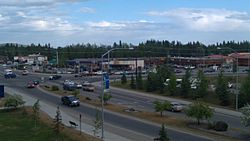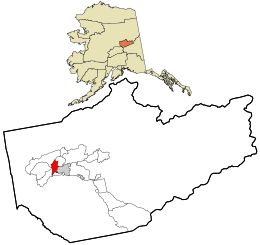College, Alaska facts for kids
Quick facts for kids
College, Alaska
Trothyeddha'
|
|
|---|---|

The intersection of Alumni Drive/College Road with Farmers Loop Road/University Avenue is the historic and commercial center of the College community. Photo taken June 2011 from the side of Troth Yeddha' (College Hill), upon which the University of Alaska Fairbanks campus sits.
|
|

Location within Fairbanks North Star Borough and the state of Alaska
|
|
| Country | United States |
| State | Alaska |
| Borough | Fairbanks North Star |
| Area | |
| • Total | 19.12 sq mi (49.53 km2) |
| • Land | 18.71 sq mi (48.46 km2) |
| • Water | 0.41 sq mi (1.07 km2) |
| Elevation | 449 ft (137 m) |
| Population
(2020)
|
|
| • Total | 11,332 |
| • Density | 605.60/sq mi (233.82/km2) |
| Time zone | UTC-9 (Alaska (AKST)) |
| • Summer (DST) | UTC-8 (AKDT) |
| ZIP code |
99709
|
| Area code(s) | 907 |
| FIPS code | 02-16750 |
| GNIS feature ID | 1400578 |
College is a special kind of community in Fairbanks North Star Borough, Alaska, United States. It's called a census-designated place (CDP). This means it's an area that looks like a town but isn't officially a city. In the local Lower Tanana language, it's called Trothyeddha'.
College is right next to the city of Fairbanks. It's home to the University of Alaska Fairbanks, which is a big part of the community. Many people think of College as part of Fairbanks, not a separate place. The university helps with fire and ambulance services. The university police and Alaska State Troopers work together to keep the area safe.
In 2020, about 11,332 people lived in College. It's the third-largest CDP in Alaska.
Contents
Geography: Where is College, Alaska?
College is located in Alaska at a specific point on the map: 64.848302 degrees North and -147.827194 degrees West.
The area covers about 19.1 square miles (49.5 square kilometers). Most of this area, about 18.7 square miles (48.5 square kilometers), is land. The rest, about 0.4 square miles (1.1 square kilometers), is water.
Climate: What's the Weather Like?
College has a subarctic climate. This means it has very long, cold winters and short, cool summers.
The hottest temperature ever recorded in College was 94°F (34°C). This happened on June 16, 1969, June 26, 1983, and June 22, 1991. The coldest temperature ever recorded was a super chilly -66°F (-54°C) on December 28, 1961.
| Climate data for College, Alaska, 1991–2020 normals, extremes 1948–present | |||||||||||||
|---|---|---|---|---|---|---|---|---|---|---|---|---|---|
| Month | Jan | Feb | Mar | Apr | May | Jun | Jul | Aug | Sep | Oct | Nov | Dec | Year |
| Record high °F (°C) | 52 (11) |
49 (9) |
57 (14) |
71 (22) |
88 (31) |
94 (34) |
92 (33) |
93 (34) |
82 (28) |
71 (22) |
49 (9) |
45 (7) |
94 (34) |
| Mean maximum °F (°C) | 31.0 (−0.6) |
36.3 (2.4) |
43.5 (6.4) |
60.2 (15.7) |
75.4 (24.1) |
84.0 (28.9) |
84.2 (29.0) |
79.3 (26.3) |
67.8 (19.9) |
53.9 (12.2) |
32.4 (0.2) |
32.2 (0.1) |
86.4 (30.2) |
| Mean daily maximum °F (°C) | 2.2 (−16.6) |
12.0 (−11.1) |
23.6 (−4.7) |
44.0 (6.7) |
60.3 (15.7) |
70.1 (21.2) |
71.3 (21.8) |
65.1 (18.4) |
53.8 (12.1) |
33.2 (0.7) |
12.1 (−11.1) |
5.0 (−15.0) |
37.7 (3.2) |
| Daily mean °F (°C) | −4.7 (−20.4) |
3.3 (−15.9) |
12.2 (−11.0) |
32.9 (0.5) |
48.6 (9.2) |
59.0 (15.0) |
61.2 (16.2) |
55.3 (12.9) |
44.1 (6.7) |
25.7 (−3.5) |
5.6 (−14.7) |
−1.5 (−18.6) |
28.5 (−2.0) |
| Mean daily minimum °F (°C) | −11.5 (−24.2) |
−5.3 (−20.7) |
0.7 (−17.4) |
21.7 (−5.7) |
36.8 (2.7) |
47.9 (8.8) |
51.0 (10.6) |
45.6 (7.6) |
34.5 (1.4) |
18.2 (−7.7) |
−0.9 (−18.3) |
−8.0 (−22.2) |
19.2 (−7.1) |
| Mean minimum °F (°C) | −38.6 (−39.2) |
−29.2 (−34.0) |
−20.7 (−29.3) |
0.0 (−17.8) |
24.9 (−3.9) |
37.1 (2.8) |
41.4 (5.2) |
33.6 (0.9) |
22.3 (−5.4) |
0.3 (−17.6) |
−21.5 (−29.7) |
−30.3 (−34.6) |
−41.7 (−40.9) |
| Record low °F (°C) | −60 (−51) |
−52 (−47) |
−40 (−40) |
−24 (−31) |
3 (−16) |
27 (−3) |
32 (0) |
24 (−4) |
5 (−15) |
−27 (−33) |
−45 (−43) |
−66 (−54) |
−66 (−54) |
| Average precipitation inches (mm) | 0.66 (17) |
0.57 (14) |
0.45 (11) |
0.37 (9.4) |
0.61 (15) |
1.92 (49) |
2.49 (63) |
2.37 (60) |
1.56 (40) |
0.87 (22) |
0.83 (21) |
0.64 (16) |
13.34 (337.4) |
| Average snowfall inches (cm) | 10.4 (26) |
9.9 (25) |
7.1 (18) |
3.6 (9.1) |
0.8 (2.0) |
0.0 (0.0) |
0.0 (0.0) |
0.0 (0.0) |
2.3 (5.8) |
7.5 (19) |
11.2 (28) |
11.5 (29) |
64.3 (161.9) |
| Average extreme snow depth inches (cm) | 19.8 (50) |
23.2 (59) |
24.2 (61) |
20.7 (53) |
2.2 (5.6) |
0.0 (0.0) |
0.0 (0.0) |
0.0 (0.0) |
1.8 (4.6) |
6.1 (15) |
11.5 (29) |
16.2 (41) |
25.7 (65) |
| Average precipitation days (≥ 0.01 in) | 8.8 | 7.5 | 5.7 | 4.1 | 6.8 | 12.1 | 14.4 | 16.0 | 12.3 | 9.7 | 9.8 | 9.0 | 116.2 |
| Average snowy days (≥ 0.1 in) | 10.1 | 8.5 | 6.8 | 3.2 | 0.7 | 0.0 | 0.0 | 0.0 | 1.0 | 8.7 | 11.3 | 10.7 | 61.0 |
| Source 1: NOAA | |||||||||||||
| Source 2: National Weather Service | |||||||||||||
People and Population in College
| Historical population | |||
|---|---|---|---|
| Census | Pop. | %± | |
| 1930 | 61 | — | |
| 1940 | 234 | 283.6% | |
| 1950 | 424 | 81.2% | |
| 1960 | 1,755 | 313.9% | |
| 1970 | 3,434 | 95.7% | |
| 1980 | 4,043 | 17.7% | |
| 1990 | 11,249 | 178.2% | |
| 2000 | 11,402 | 1.4% | |
| 2010 | 12,964 | 13.7% | |
| 2020 | 11,332 | −12.6% | |
| source: | |||
College first appeared on the U.S. Census in 1930 with 61 people. It became a census-designated place in 1980.
In 2000, there were 11,402 people living in College. About 77.9% of the people were White. Other groups included 9.0% Native American, 3.2% Asian, and 3.1% Black or African American. About 3.5% of the population was Hispanic or Latino.
There were 4,104 homes in College. About 37.1% of these homes had children under 18 living there. The average home had 2.60 people.
About 26.7% of the people were under 18 years old. About 16.8% were between 18 and 24. The median age was 30 years old. This means half the people were younger than 30 and half were older.
Education: Schools in College
The Fairbanks North Star Borough School District runs the public schools in College.
- University Park Elementary (U-Park) is the oldest school. It opened in 1958. A new building for U-Park was built in the 1990s. The old school building is now used by the UAF Community and Technical College.
- Other elementary schools in the area include Pearl Creek Elementary and Woodriver Elementary.
- West Valley High is the high school that serves students in College.
- Middle school students usually go to Randy Smith Middle and Ryan Middle, which are in Fairbanks.
- There are also special schools called charter schools in College. These include Effie Kokrine Charter, Watershed Charter, and Hutchison High. These schools have open enrollment, meaning students from anywhere can apply to attend them.
The Yukon–Koyukuk School District also has its main office in College. This district manages schools in many rural areas of Interior Alaska.
See also
 In Spanish: College (Alaska) para niños
In Spanish: College (Alaska) para niños

